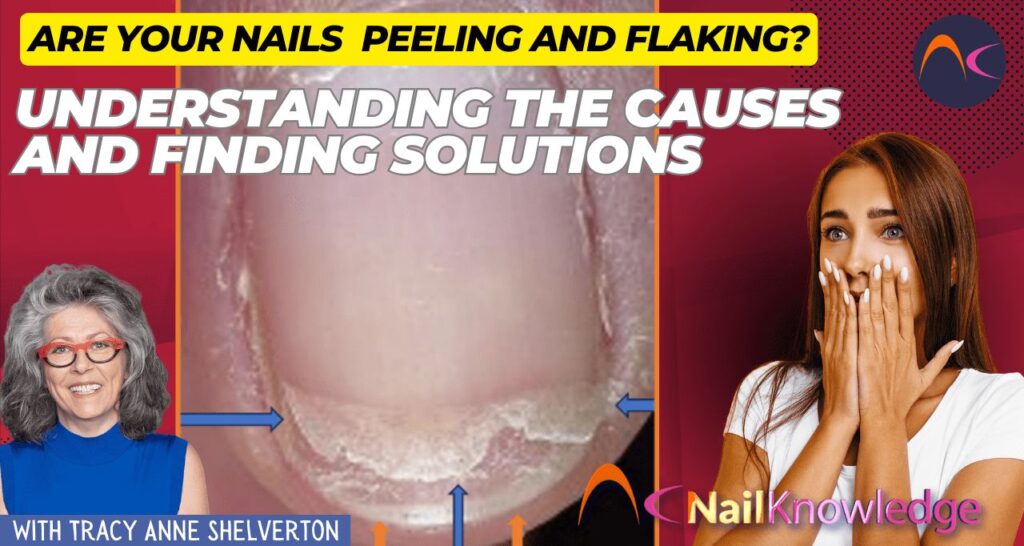Understanding the Causes of peeling nails and Finding Solutions
Your nails are not just an accessory; they can provide valuable insights into your overall health. Healthy nails are strong, smooth, and free from peeling and flaking. However, if you notice your nails becoming weak, brittle, and or showing signs of nail peeling, it might be an indication that something is going on inside your body.
In this article, we will delve into the common reasons why nails peel and flake, explore how to address these issues, and understand when it’s time to seek professional advice from a dermatologist or medical hand specialist. By understanding the causes and implementing appropriate care, you can achieve stronger and healthier nails.
First let us define different kinds of nail plate delamination (peeling)
There is a normal delamination caused by using your nails as tools or maybe catching a nail plate that is split already in a hair. This is quite easy to fix with good professional products and paying attention to nail maintenance.
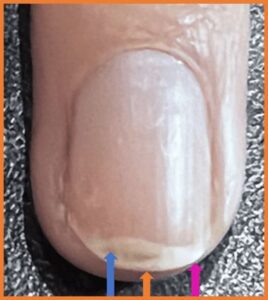
Here we see 3 thin layers of ‘normal’ delamination (nail peeling) caused by a fracture in the nail plate layers from normal wear & tear maybe the hands in & out of water a lot, the shrinkage of the nail plate when it dries out causes the fractures to become bigger and the nail plate just unravels
Then there is a chronic delamination usually caused by psoriasis affecting the middle nail matrix. This is called onychoschizis. Onychoschizis is notoriously difficult to handle.
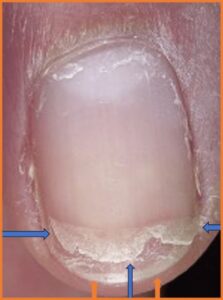
Onychoschizis happens when the middle layers of the nail plate are no longer bound together. We see this often when the middle matrix is affected by psoriasis, the nail plate cells are not bound together properly so the nail plate literally splits in half horizontally.
- The blue arrows show the upper half of the nail plate is completely loose
- The orange arrows show the lower half of the nail plate that is now completely unstable, its almost impossible to put an artificial nail product on this and keep it from lifting
This is a tough condition to deal with in the salon even with the most amazing professional products on the market this is though to deal with because the layers are independent of each other and in perpetual motion.
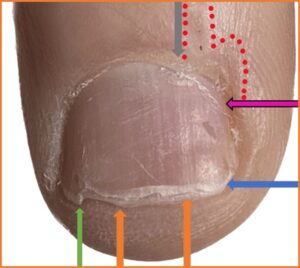
- The grey arrow shows that the PNF is being pulled along with the growing nail plate
- The red dots show area of skin layer damage – maybe from pulling the skin
- The pink arrow shows the cuticle on the nail plate
- The blue arrow the first spit in the nail plate
- The orange arrows show the rest of the nail plate
- The green arrow shows the fracture at the free edge from some kind of trauma
With a little love, coaching, oil & lotion we can recover this nail unit well.
Beaded Ridge Nail Plates with upper layer delamination
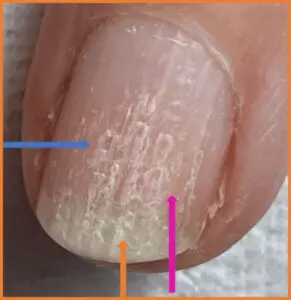
These nail plates are defective from the moment the nail plate cells are born and the older they become the more they unravel, this is common when groves are present in the nail plate. Filing the surface smooth is not the solution this will cause the whole nail plate to become unstable. We need to reconnect the upper layers, there are professional products on the market that can do this very well and nail maintenance with oils and lotions is essential.
Understanding the Role of Water in Peeling Nails
One of the most common reasons for peeling nails is repetitive wetting and drying of hands. If you work in professions that require frequent soaking of hands, such as hairdressing, house cleaning or bar work, your nails may become more susceptible to peeling.
When your nails are frequently exposed to water, they absorb moisture, causing the nail plate to swell. As a result, the nail becomes soft and vulnerable to damage from minimal trauma. When the nails harden they compress, this causes small cracks in the structure of the nail plate over time this repetition of softening and hardening causes the nail plate structure to fracture and pealing and splitting is the result. To prevent this, consider wearing gloves while doing dishes or any other activity involving prolonged contact with water. After washing your hands, make sure to dry them thoroughly and apply a quality nail oil and hand cream to replenish lost moisture.
The Pitfalls of Excessive Nail Buffing
While buffing your nails can create a smooth and polished appearance, excessive buffing has detrimental effects on your nail plates and their health in general.
Buffing your nail plates removes the most valuable layer of the nail plate – remember we talked about the upper layer of the nail plate being similar to the roof tiles on your house, removing them is insanity and doing that before the rain comes is total madness.
Always try to refrain from buffing your nail plates, if you want your nails to ‘look‘ healthy then make them healthy. Use a simple base coat nail varnish to provide a ‘healthy looking shine.
Harsh Chemicals in Products
The chemicals present in some nail products, like adhesive for gel or acrylic nails, as well as ingredients in hand soaps, sanitizers, and laundry detergents, can also contribute to peeling nails. These chemicals can strip the nails of their natural oils and moisture, leading to dryness and peeling. Opt for products that contain milder or natural chemical agents that are less harsh on the nails.
Breaking Bad Habits: How Nail Trauma Leads to Nail Peeling
Engaging in certain habits or activities that put stress on your nails can cause them to peel. For example, picking at polish, biting your nails, or using them to open objects can disrupt the adhesion between nail cells, leading to peeling.
To prevent nail trauma, avoid aggressive polish removal methods and instead use the remover recommended by your product supplier. A professional nail strengthener will really help but to maintain the quality after application nail maintenance with a good quality nail oil and hand lotion containing Ureum & Allantoïne is essential.
Nutrient Deficiency
Your diet plays a crucial role in maintaining healthy nails. Peeling nails have been associated with nutrient deficiencies, such as low levels of calcium, iron, vitamin D, and B vitamins like biotin. These essential nutrients contribute to the growth and strength of the nail’s keratin, the protein responsible for nail tissue.
To address nutrient deficiencies, focus on consuming a well-balanced diet rich in fruits, vegetables, and lean proteins. If necessary, consult your doctor to determine if supplementation is required to meet your nutritional needs.
Drink lots of water.
Thyroid Issues
Thyroid disorders can also impact the health of your nails. A slow turnover rate of skin and nails caused by thyroid disease can lead to older nail tissue staying around for longer periods. As a result, the nails become brittle and prone to peeling.
If you experience other symptoms associated with thyroid issues, such as weight changes, anxiety, fatigue, or brain fog, consider consulting a healthcare professional. Blood tests and a comprehensive examination can help diagnose and manage any thyroid-related concerns.
Peeling Nails and Onychomycosis: Understanding the Connection
Onychomycosis, a fungal infection of the nail, is another potential cause of peeling nails. In addition to peeling, you may notice thickening of the nails and white or yellow-brown discoloration. If you suspect a fungal infection, consult a medical hand specialist or a dermatologist for an accurate diagnosis and appropriate treatment. Fungal infections can be challenging to treat, and your dermatologist can recommend oral antifungal medication to promote nail healing. Again, nail maintenance products are important.
Hand Eczema
Skin conditions like eczema can also affect the health of your nails, leading to peeling. Eczema can cause dry and flaky skin on the hands, with red inflamed areas that are prone to cracks and fissures, causing intense itching and burning.
To prevent nail peeling due to eczema, ensure you manage the symptoms by keeping the skin on your hands hydrated with a suitable moisturizer. Regular moisturization can help soothe eczema-related inflammation and create a protective barrier for the nails. Look for moisturizers that are gentle and formulated specifically for sensitive skin to avoid further irritation.
Along with Eczema, Psoriasis or Alopecia can also cause nail problems. The reason that these skin conditions can affect your nails is that the nail matrix is also created by the same Adult Stem Cells that create your skin.
Lack of Exfoliation
Exfoliation plays a vital role in maintaining healthy nails. Just as dead skin cells accumulate on the surface of your skin, the nail is also composed of layers of dead nail cells. Without proper exfoliation, these dead cells can build up and nails it will look like you are peeling.
When to Seek Professional Guidance for Persistent Peeling Nails
While peeling nails are a common issue and often not a cause for concern, there are instances where seeking professional help is necessary. If you have tried home remedies and your nails are not improving, or if peeling occurs suddenly and persists despite your nail salon or podiatrists efforts, it could be advisable to consult a medical hand specialist, dermatologist or primary care physician.
Tips for Stronger and Healthier Nails
- Maintain a well-balanced diet rich in essential nutrients, including calcium, iron, vitamin D, and biotin, to support healthy nail growth.
- Avoid buffing your nails, and use a moisturizer or nail oil to retain moisture.
- Protect your nails from trauma and avoiding habits like picking or biting nails.
- Keep your hands and nails dry when possible and wear gloves during activities that involve prolonged exposure to water.
- If you suspect a fungal infection or another skin condition, seek professional evaluation and treatment.
- Nail maintenance and care is essential for healthier nail growth. Use quality nail care oils and lotions. Avoid extra additives in your nail products such as artificial colours or perfumes
- Be patient and consistent with your nail care routine, as it may take time to see improvements in nail health.
In Conclusion: Nurturing Healthy Nails and Conquering Nail Peeling Challenges
Peeling and flaking nails can be bothersome, but with the right care and attention, you can restore their strength and health. By understanding the potential causes and making appropriate lifestyle changes, you can achieve stronger and more resilient nails.
If you are uncertain about the underlying cause of your nail issues or if your nails are not responding to home remedies, don’t hesitate to seek professional guidance. A medical hand specialist can help with home care advice and professional treatment. A dermatologist can help identify any underlying health conditions and provide tailored recommendations for your specific needs.
Remember, your nails are a reflection of your overall health, and taking care of them goes beyond aesthetics. With proper care and attention, you can enjoy healthy, beautiful nails that complement your overall well-being.

